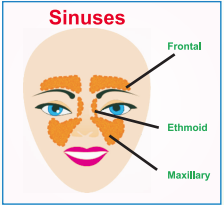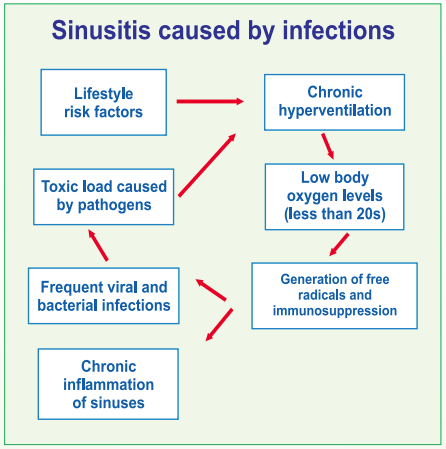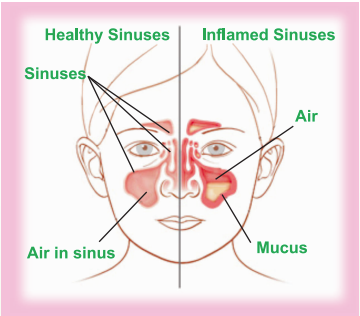Yogic Management of Sinusitis
Yogic Management of Sinusitis
Introduction
Sinusitis is an inflammation of the paranasal sinuses. This may be due to bacterial, fungal, viral, infection, allergic or autoimmune diseases. The sinuses are small, air-filled cavities behind the cheek bones, behind the forehead, either side of the bridge of the nose and behind the dyes. The sinuses open up into the cavity of nose and help control the temperature and water content of the air reaching the lungs. The mucus produced naturally by the sinuses usually drains into the nose through small channels. These channels can become blocked when the sinuses are infected and inflamed.
Newer classification of sinusitis refer to it as rhino-sinusitis, taking into account the thought that inflammation of the sinuses cannot occur without some inflammation of the nose as well (rhinitis). This inflammation leads to blockage of the normal sinus drainage pathways (sinus ostia), which in turn leads to mucus retention, hypoxia, decreased muco-ciliary clearance and predisposition to bacterial growth.
Sinusitis can be divided into the following categories
- Acute sinusitis is defined as symptoms of less than 4 weeks duration.
- Subacute sinusitis is defined as symptoms of 4 to 8 weeks duration.
- Recurrent acute sinusitis is often defined as three or more episodes per year, with each episode lasting less than 2 weeks duration.
Causes and Risk factors
 Sinuses can become inflamed and blocked due to various causes, but the most common cause is a viral infection. The common viral infections are cold and flu. Acute sinusitis is often associated with allergic rhinitis and upper respiratory infections. A deviated nasal septum or other obstruction of the nose may trap fluid in a sinus, causing chronic sinusitis. Dental infections such as tooth abscess may spread into the sinus and infect it directly.
Sinuses can become inflamed and blocked due to various causes, but the most common cause is a viral infection. The common viral infections are cold and flu. Acute sinusitis is often associated with allergic rhinitis and upper respiratory infections. A deviated nasal septum or other obstruction of the nose may trap fluid in a sinus, causing chronic sinusitis. Dental infections such as tooth abscess may spread into the sinus and infect it directly.
The risk factors due to which sinuses become more vulnerable to infection include irritants (air pollution, smoke and chemicals, such as pesticides, disinfectants and household detergents), allergies (allergic rhinitis, pollen and hay fever) and narrow nasal passages (facial injury or nasal polyps inside the nose).
Sinusitis may cause debilitating symptoms producing distress and morbidity to the patient. It may flare up spontaneously or may follow respiratory infections such as colds.

Common Symptoms of Sinusitis
The classic symptoms of chronic (long lasting) sinusitis are:
- Dull pain or pressure across the midface, especially between or deep into the eyes
- Headache that occurs daily for weeks at a time and is often notably worse in the morning and with head movement
- Nasal congestion
- Post-nasal dip
The classic symptoms of acute (short lasting) sinusitis are:
 Fever
Fever- Nasal obstruction
- Husky voice
- Pus-like (purulent) nasal discharge
- Loss of sense of smell
- Facial pain or headache that is sometimes aggravated by bending
Maxillary sinusitis (the most common type) manifests as cheek or dental pain. Forehead pain indicates frontal sinusitis. Pain at the bridge of the nose or behind the eye suggests ethmoid sinusitis. Pain is often referred to the top of the head with sphenoidal involvement.
Most people with sinusitis, have pain or tenderness in several locations and their symptoms usually do not clearly show which sinuses are inflamed.
On rare occasions, acute sinusitis can result in brain infection and other serious complications.
Yogic Management of Sinusitis
Sinusitis cases respond very well to the Yogic techniques. The treatment of choice in Yoga for Sinusitis is Kriyas and Pranayamas. The Kriyas like Kapalabhati, Sutraneti, Jalaneti and Kunjal help in reducing the hypersensitivity of the nasal mucosa and facilitate in draining the excessive mucosa stored up in the sinuses.
Om Chanting and Prayer
- Kriyas : Kunjal, Sutraneti, Jalaneti, Kapalabhati
- Sukshma Vyayamas : Selected practices
- Yogasanas : Tadasana, Urdhwahastottanasana, Matsyasana, Sarvangasana, Bhujnagasana, Gomukhasana, Mandukasana, Uttana-mandukasana, Simhasana, Shavasana.
- Pranayamas : Nadishodhana, Ujjayi, Bhramari and Bhastrika.
- Meditation : Om meditation
- (Yogic Diet) Mitahara : The diet plays an important role in the management of asthma and other respiratory conditions, including sinusitis. There are foods, which are allergic to the patient like cold food, ice cream, chocolates, other stimulants, fruits like banana etc. are to be avoided. Also, the foods which add to the mucous production should be specifically avoided.
Prevention of Sinusitis
The best way to prevent sinusitis is to avoid or quickly treat flu and cold:
- Wash hands frequently, particularly after shaking hands with others.
- Eat plenty of fruits and vegetables, which are rich in antioxidants and other chemicals that could boost the immune system and help the body to resist infection.
- Reduce stress.
- Avoid exposure to cigarette smoke and environmental pollutants.
- Use a humidifier to increase moisture the nose and sinus areas.
- Drink plenty of fluids to increase moisture within the body.
- Take decongestants during an upper respiratory infection.
- Treat allergies promptly and appropriately.
- Avoid chilled and preserved foods as they contain preservatives which are strong allergens to many persons.
Yogic Practices for the Management of Sinusitis

Last Modified : 8/25/2023
This topic covers the information about Hives.
This topic provides information about Yogic Manage...
This topic gives complete Information related to D...
Provides information about Do’s and Don’ts of Yoga...
